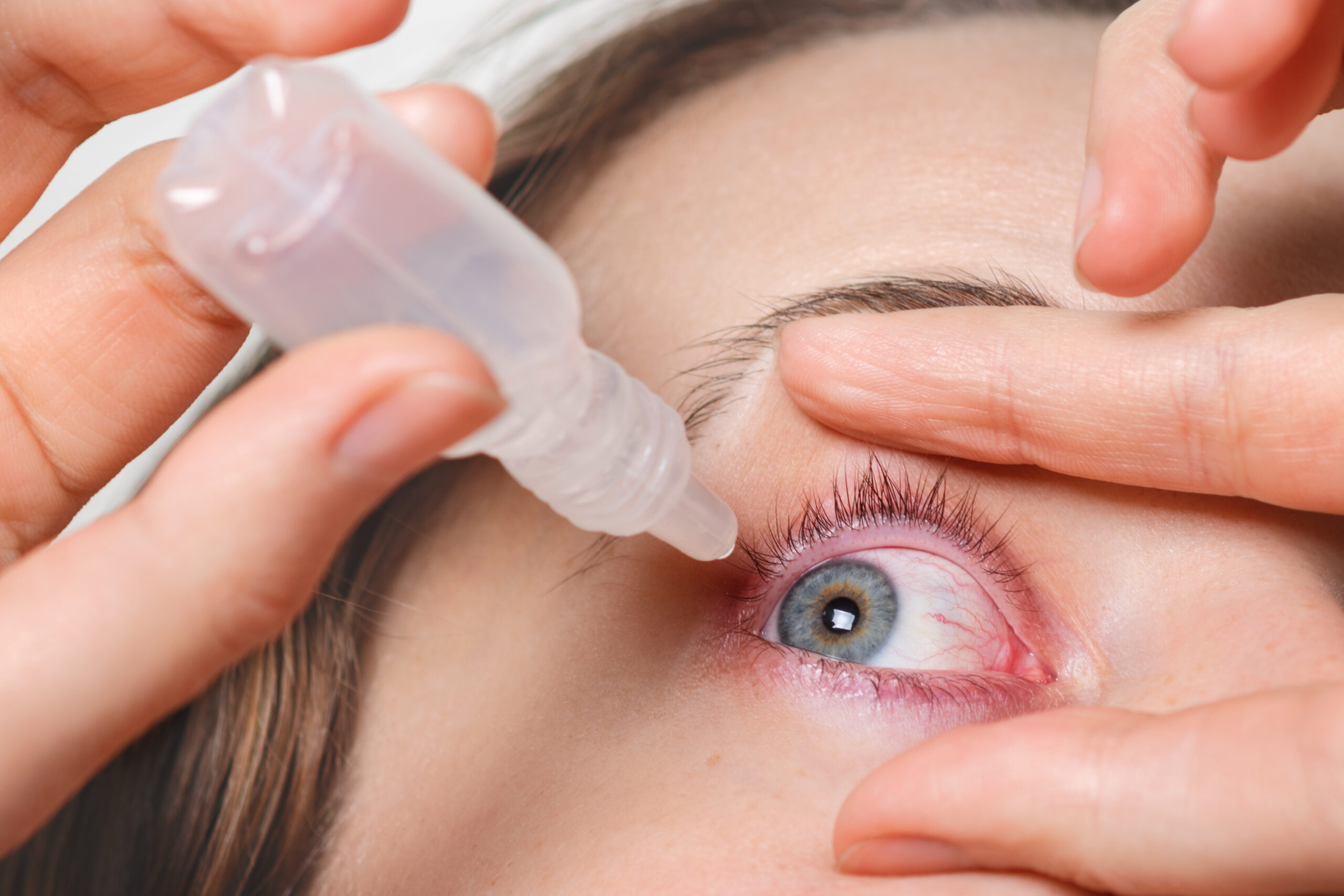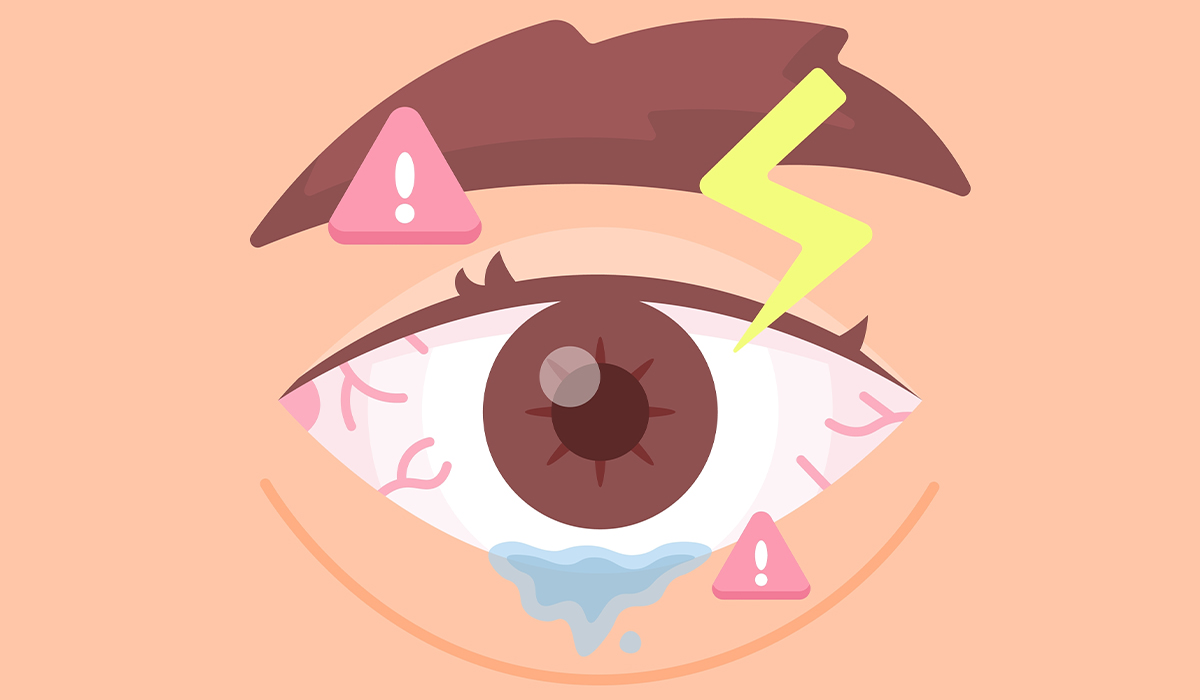Eye drops treat various eye conditions by applying the solution to the conjunctival sac while gently pulling down the lower eyelid. This treatment can be administered while lying down, sitting, or standing. Eye drops vary in composition and purpose, such as antibiotic eye drops, drops for tired eyes, pediatric eye drops, lubricating drops for dry eyes, and even eye drops for animals, as prescribed by a veterinarian.
Eye drops![]() typically contain water and polymers, which help retain water on the eye's surface. The quality of eye drops depends on the polymers used in them. Hyaluronic acid is a crucial component of eye drops because it is also a natural component of the eye's structure.
typically contain water and polymers, which help retain water on the eye's surface. The quality of eye drops depends on the polymers used in them. Hyaluronic acid is a crucial component of eye drops because it is also a natural component of the eye's structure.
Another method of moisturizing the eyes is physiological saline, but this procedure does not provide long-term effects. Therefore, it should only be used on an ad hoc basis.
Eye drops usually contain the following ingredients:

Hyaluronic acid![]() is a viscoelastic substance with physicochemical properties that allow it to be used in preparations (artificial tears). The solution adheres well to the surface of the cornea and conjunctiva, is characterized by appropriate viscosity and elasticity, and ensures long-term hydration of the cornea.
is a viscoelastic substance with physicochemical properties that allow it to be used in preparations (artificial tears). The solution adheres well to the surface of the cornea and conjunctiva, is characterized by appropriate viscosity and elasticity, and ensures long-term hydration of the cornea.
Heparin![]() is a moisturizing substance. It soothes irritations and accelerates the regeneration of the conjunctiva and cornea.
is a moisturizing substance. It soothes irritations and accelerates the regeneration of the conjunctiva and cornea.
Ectoine![]() is a substance that soothes inflammation in the eye, stabilizes the tear film, and relieves itching and burning of the eye.
is a substance that soothes inflammation in the eye, stabilizes the tear film, and relieves itching and burning of the eye.
Vitamin A![]() is essential for the growth and regeneration of epithelium. It contributes to maintaining the good condition of the skin and mucous membranes. It plays an essential role in the vision process. After chemical changes, it is a component of the visual pigment, and its deficiency leads to the so-called night blindness.
is essential for the growth and regeneration of epithelium. It contributes to maintaining the good condition of the skin and mucous membranes. It plays an essential role in the vision process. After chemical changes, it is a component of the visual pigment, and its deficiency leads to the so-called night blindness.
Vitamin A deficiency can also cause changes in the skin, keratinization of the epithelium, drying of the conjunctiva, and changes in the central nervous system.
Preservatives![]() present in eye preparations are chemical compounds with bactericidal action. They protect the preparation from the growth of microorganisms after the bottle is opened. Microbiological contamination can cause infections of the eye surface and change the drug's physicochemical properties.
present in eye preparations are chemical compounds with bactericidal action. They protect the preparation from the growth of microorganisms after the bottle is opened. Microbiological contamination can cause infections of the eye surface and change the drug's physicochemical properties.
Preservatives significantly extend the durability of the preparation after the drug bottle is opened. From an economic point of view, these preparations are cheaper because they do not require disposable packaging or specialist applicators to maintain sterility in the bottle, which increases the preparation cost. However, despite the above advantages, preservatives have a very negative effect on the surface of the eyeball.
When it is necessary to use eye drops![]() regularly, you should work out a schedule for their administration. If the doctor decides they must be applied thrice a day, instilling them every 8 hours is unnecessary. It is best to adjust the intake of drops to the rhythm of the day. Only patients suffering from severe eye diseases must be precise when using these preparations. In other situations, the time of installation of the drug is not necessary for the course of therapy.
regularly, you should work out a schedule for their administration. If the doctor decides they must be applied thrice a day, instilling them every 8 hours is unnecessary. It is best to adjust the intake of drops to the rhythm of the day. Only patients suffering from severe eye diseases must be precise when using these preparations. In other situations, the time of installation of the drug is not necessary for the course of therapy.
The drops can be taken lying down, sitting, or standing. People who hate this procedure can apply the preparation to closed eyelids (it is better in a lying position). Then, a portion of the drug is placed in the hollow by the nose—after opening the eyes, the drug will flow into the eye.
If you apply the drops yourself, you should pull down the lower eyelid, instill the preparation, and press the corner of the eye with your finger right next to the nose. This blocks the flow of tears, and the drops, instead of flowing into the nose, remain on the eyeball longer, which affects their better absorption. Blinking for a while is a good idea, as is spreading the medication over the eye surface.
When choosing eye drops, it is worth paying attention to their purpose. Usually, we select moisturizing preparations that are supposed to soothe irritated conjunctiva. Allergy sufferers should choose eye drops without preservatives. In this case, the most important thing is to minimize the side effects leading to irritation.
A separate group comprises people wearing contact lenses who should also use moisturizing preparations. The composition of eye drops is also significant. In most of them, the basic element is water and sodium hyaluronate, a component of human tears. When buying eye drops, it is also worth paying attention to the product's expiration date, which is counted from the moment of opening. Usually, it does not exceed six months. After this time, we should buy new eye drops.
When choosing eye drops, it is worth focusing on the following criteria:
The best quality eye drops are distinguished by the smallest possible number of preservatives, an extended expiry date after opening the package, high comfort of eye instillation, and an appropriate price.

Eye drops prescribed for eye conditions such as conjunctivitis contain antibiotics and sulfonamides, and they require a prescription from an ophthalmologist. When using eye drops with antibiotics, it's important to follow the detailed instructions provided by the specialist. Similar to oral antibiotics, these eye drops can be administered as frequently as every hour, and the treatment typically lasts 4-7 days.
It's crucial not to interrupt the treatment, as the initial improvement observed is due to the loading dose effect. It means that initially, the drops are applied every hour and then less frequently, such as every five hours.
When choosing eye drops, opt for ones without preservatives for the best and safest results. Look for single-use “minims” or packages with sterilizing filters free from preservatives. You can also find drops with disappearing preservatives at pharmacies, but these can still have a negative impact.
Preservatives can harm the tear film. Ammonium salts, for instance, act like detergents and may damage the outer fat layer of the tear film. This can lead to the eyes drying out, worsening the symptoms of dry eye syndrome.
For those who wear contact lenses daily, it's necessary to use eye drops without preservatives. Ammonium salts can discolor and damage lenses, affecting their properties and vision. Eye drops with preservatives can get between the cornea and the contact lens, causing discomfort, pain, burning, or itching.
Eye drops for tired eyes narrow the conjunctiva and prevent it from reddening. However, these preparations should not be used all the time because they can lead to severe diseases. In addition to over-the-counter eye drops for tired eyes, occupational hygiene (e.g., taking breaks while working in front of a monitor) should be practiced.
Eye drops are purchased for children with dry eye syndrome. This condition usually affects children who live in cities, often staring at the display of an electronic device or spending time in air-conditioned rooms. It is best to choose products without preservatives for children.
The pharmaceutical market also offers so-called artificial tears![]() containing sodium hyaluronate, a component of human tears. These eye drops are the safest. They do not irritate – they soothe tired eyes.
containing sodium hyaluronate, a component of human tears. These eye drops are the safest. They do not irritate – they soothe tired eyes.
The correct dosage of eye drops![]() is important in preventing the treated condition. The conjunctival sac to which the drops are applied has a limited capacity, a maximum of approx. 30 microlitres fluid. However, one drop of medication delivered to the eye is approximately 40-70 microlitres. Therefore, you should not apply more drops to the eye than indicated on the package leaflet of the given preparation.
is important in preventing the treated condition. The conjunctival sac to which the drops are applied has a limited capacity, a maximum of approx. 30 microlitres fluid. However, one drop of medication delivered to the eye is approximately 40-70 microlitres. Therefore, you should not apply more drops to the eye than indicated on the package leaflet of the given preparation.
Most drops will leak out or enter the nose or digestive tract through the tear ducts. In many cases, this does not affect the health condition, but when using severe drugs, the patient may experience undesirable side effects. This problem primarily concerns people struggling with bronchial asthma or hypertension.
Many people have trouble using eye drops. This task is neither easy nor pleasant. Incorrectly used drops can irritate, causing discomfort. Of course, incorrectly applied drops will not have the expected effect, and the entire treatment must be repeated.
The first step in using eye drops is to wash your hands thoroughly. Remove any dirt that could potentially get into your eye. Then, tilt your head back or lie down. The lower eyelid should be tilted so the eye drops do not flow out of its area and into the conjunctival sac.
The dropper should be held 1-2 cm from the eye, closer to the outer corner of the eye. After applying the drops, press the tear point so the drops do not get there. Many people forget to do this. You can also close your eyelids for a few seconds to spread the drops well on the eyeball.

The efficiency of the conjunctival sac is only one drop. Therefore, it is not worth applying larger amounts because it will not be able to absorb them and will remove the excess. It has advantages because you should not be afraid of applying too much preparation at once.
It is also important not to touch the tip of the applicator to the eyelashes, the skin around the eyes, or the eye because this is how impurities are transferred. Sometimes, the treatment requires the use of several different types of eye drops at the same time. In such a case, you should take about 15-minute breaks between applications, allowing each drug to work.
How eye drops are stored is also significant for the success of the treatment. To prevent them from losing their valuable properties, they should be stored in a dry place at room temperature. Because sunlight can weaken the effect of the drops, they should not be exposed to direct sunlight.
Eye drops are often necessary to treat dry, burning, or aching eyes. However, proper eye hygiene can prevent unpleasant ailments. The following guidelines can help you properly care for your eyes.
Spending long hours at work or home in front of a monitor is worth getting glasses. Even if you do not have a vision defect, they may be so-called zeros. Glasses block blue radiation emitted by screens and relieve eyesight.
If you control the humidity in the room where you work or rest, your eyes will be much less dry. This is especially true in winter when heating additionally dries the ambient air.
For people with visual impairments, you should check with an optometrist whether the glasses you are wearing are perfectly matched to the defect.
During work, you should ensure the highest possible comfort, i.e., a good monitor, a comfortable chair, lighting, and the appropriate number and duration of breaks.
Table of Contents

Eye infections are common conditions where an eye becomes red, itchy, and painful. What are the common causes? How is… read more »

An ophthalmologist is an eye doctor. They are trained to diagnose, treat, and manage eye and vision conditions. Each part… read more »

Pink eye is one of the most frequently diagnosed ophthalmological diseases. It may be bacterial, allergic or viral. What are… read more »

Strabismus is an eye misalignment, a condition when eyes look in different directions. It can affect both children and adults.… read more »

The knee joint comprises an extraordinary portion of the meniscus. It comprises of two crescent-shaped bits of cartilage. Settled between… read more »

Eye twitching, what science individuals call myokymia, is when your eye muscle moves by itself again and again without you… read more »

Sjogren's syndrome is an autoimmune disease that causes your white cells to attack healthy cells instead of protecting them. It… read more »

Food ingredients are added to products with the goal of improving their quality. Food additives have a number of benefits,… read more »

Eye bags, called “under-eye packs,” are a common beauty issue. They appear little swelling or puffiness beneath the eyes. How… read more »